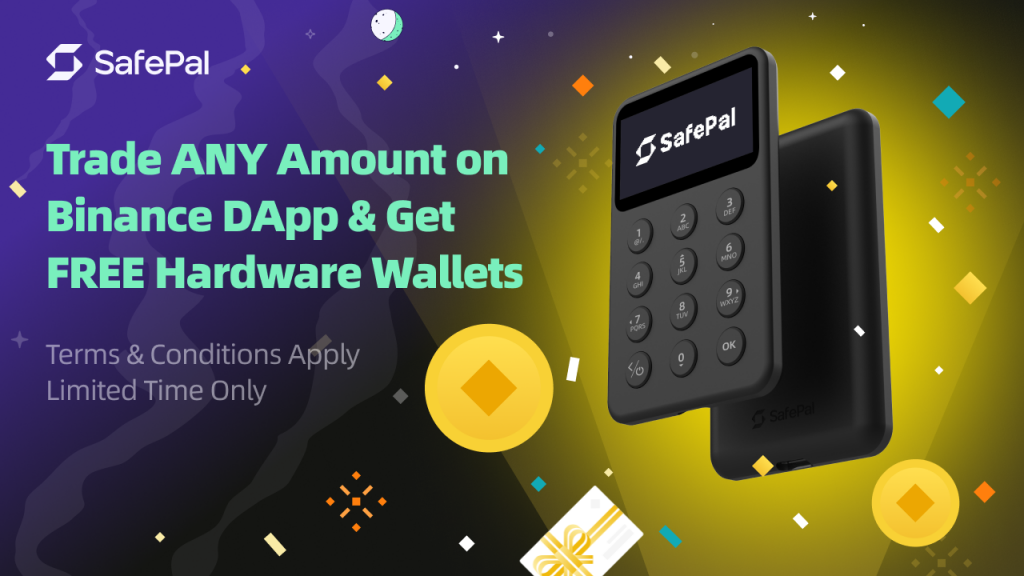Last week, we have announced integration and ecosystem partnership with Qtum and its mainnet coin $QTUM is now available on SafePal hardware wallet!
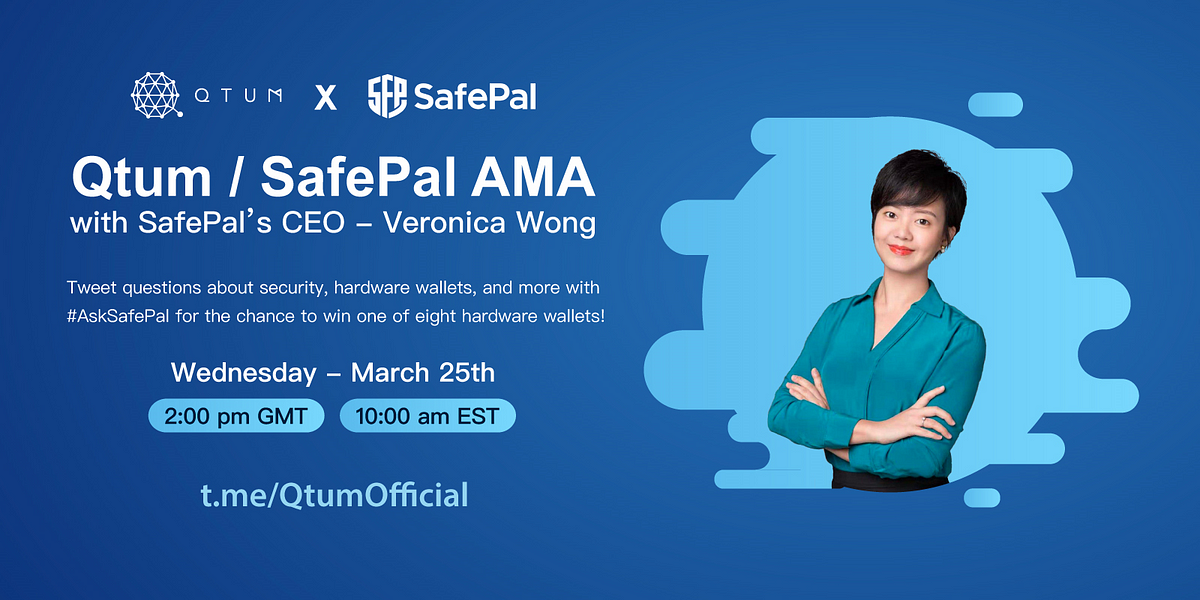
On 25 March, our CEO, Veronica had an AMA session in Qtum Telegram community and answered a series of questions about security, hardware wallet and roadmap of SafePal.
Thank you all for coming and we appreciated all these curious and insightful questions.
Here are the essential points of the session:
AMA Session is Live!
Before we start, I have some questions for you.
Please tell us about SafePal and the team behind the project.
SafePal is a cryptocurrency hardware wallet that aims to provide the most secure and user-friendly hardware wallet for the masses. The name SafePal comes from the combination of ‘pal’, which is related to the wallet, and ‘safe’, a stress word that we want to emphasize, especially when we think of security as the cornerstone of the blockchain ecosystem.
Our company was founded in Jan 2018, and we received Binance’s strategic investment in October 2018. The first hardware wallet we built, SafePal S1, was launched in May 2019, and has been sold to 60+ countries till this moment. In the last 10 months, we have been moving very fast. Till today SafePal has supported 19 blockchain, 10K+ tokens, and 10 languages already.
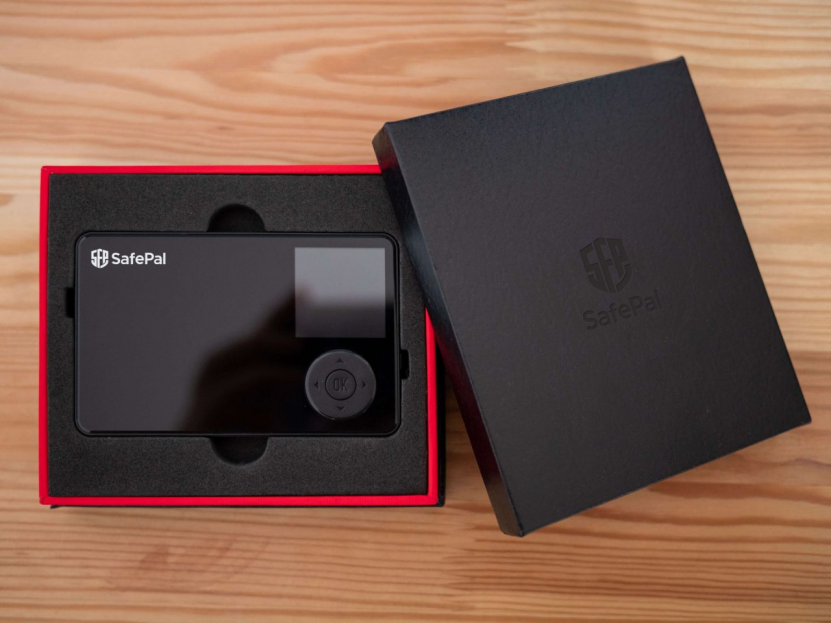
Another question… Where did the idea of SafePal originate?
That’s a long story. 🙂
Bitcoin came into my sight in 2015, when one of my friends sent me the Bitcoin white paper. I was immediately drawn into the delicate model it has depicted. I added it as a research objective and observed the market changing over the years. It was not until 2017, when we witnessed the huge success of Cryptokitties and the crypto market boom, that I started to seriously think about entering this market.
When we look closer to the real user cases of this market, we found that wallets, as the basic infrastructure in the blockchain ecosystem, still have many missing parts of it.
For example, there are hacking cases happening everyday. Though we are in a decentralized industry, there are still a lot of companies doing centralized things such as providing centralized wallet services. They could easily get away with your money stored in the wallet. For example, people complain about how cumbersome it is to use with a hardware wallet, and they are very expensive!
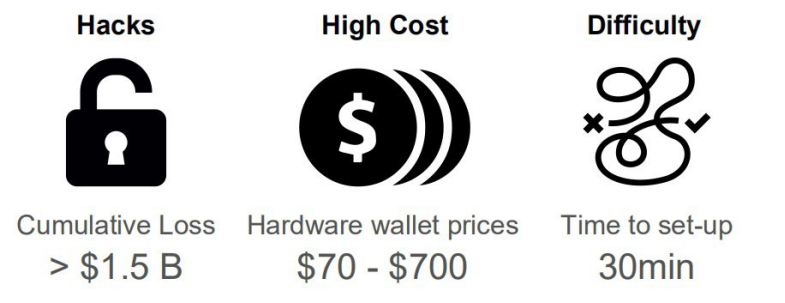
We are surprised but glad at the same time to know that there are a lot of spaces needed improvements.
And that’s how we decided to build a truly secure and user-friendly cryptocurrency wallet.
Ok ok I won’t hog all the questions, but I have 1 more…
What gives SafePal an advantage over competitors?
Very good question.
There are 2 keys I’d like to stress about this question.
1) SafePal is built with more advanced product philosophy and strong execution.
For now, SafePal S1 is the best hardware wallet with the strongest specification and best price. This proves our capability of delivering the best product for the masses.
2) SafePal is 100% user-oriented and we move very fast
SafePal S1 was launched in last May, In less than a year, we kept the pace to release new updates each 2–3 weeks. In the meantime, we pay close attention to user feedback and community reaction.
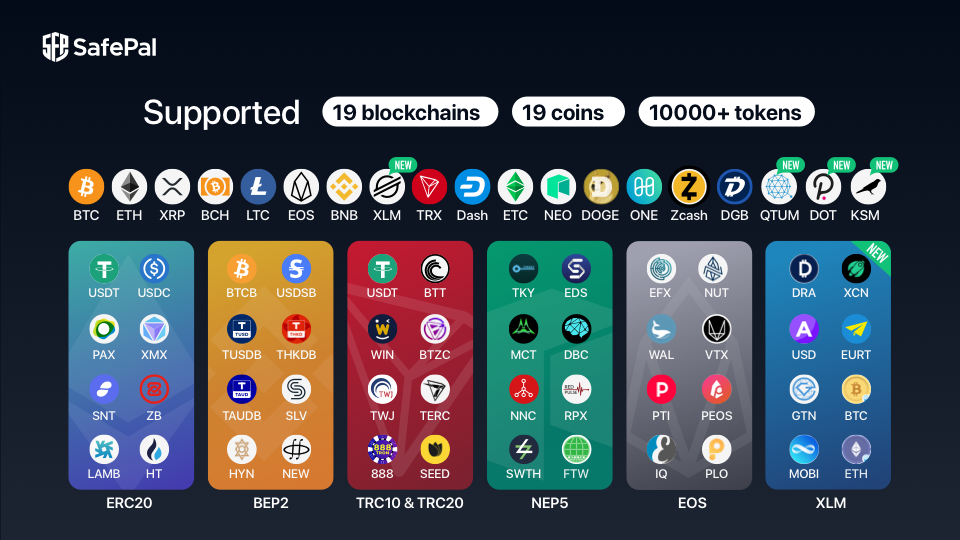
I think these are the key factors that we are able to deliver better and safer products that are loved by our community.
Glad to finally have the Qtum logo on our logo wall. 🙂
Q: What are the difference between trust wallet/paper wallet & hardware wallet? If I can create wallets for free then why I should buy a hardware wallet? And If I lose my hardware wallet then what? Can any user who found my hardware wallet can access my wallet?
A: Hardware wallet: Secure, easy to use, easy to store and simpler for daily transaction
Paper wallet: Secure, easy to lose, cannot last for a long time. Cannot support transaction features
Software wallet: less secure. Easy to use and manage
Cloud wallet: the least secure. Easy to use and manage
B: If you lose your hardware wallet, you still have your recovery seed. SafePal supports recovery mechanisms to get you backed.
Q: I’m planning to buy a Hardware wallet for my Funds! But, there are many hardware wallets like Trezor, Ledger, etc are in the Market! But, SafePal looks Attractive & with More features! But Security is very important with Features… So, Which security Measurements are used by SafePal for ensuring my Funds Safe & Secure?
In Short, Why should I Buy Safepal for My Funds security & Safety instead of other hardware wallets?
A: A lot of questions go to “why SafePal is SafePal and how is it better”. I’m going to summarize here:
A. Why SafePal is secure?
SafePal S1 adopts multi-security-schemes, including:
1) Communications: it adopts encrypted QR code communication. There is no USB cable, Bluetooth, NFC, WiFi or any other radiofrequencies inside.
2) Dual-chip architect: S1 is embedded with dual chips, one of which is an EAL5+ secure element, solely for the protection of private keys.
3) True random number generator: this is a mechanism to make sure the private key is indeed random and unique.
4) Multiple sensors: including but not limited to voltage sensor, light sensor, frequency sensor and etc. Once there is an attack (such as a brutal attack) detected, the self-destroy mechanism will be initiated and the private key and asset details will be erased.
More security details can be found here.
B. Why SafePal is better in other ways?
I have a lot of reasons to share here, including:
1) SafePal is mobile-friendly
With a SafePal S1 and a SafePal App in your phone, you can move around with your crypto securely and buy-in/out your assets at your fingertips
2) SafePal S1 doesn’t have limitation for currencies
It enables you to manage unlimited(literally) currencies in ONE device
3) SafePal S1 is super easy-to-use
With a 1.3′ high-resolution screen and slick UI design, SafePal is easy even for a new beginner
Q: The first thing that comes to mind when you think of Wallet is Ledger. I wonder what Safepal is like compared to Ledger?
A: If you are using a Ledger and Trezor, you might find the following features quite attractive:
Firstly, SafePal S1 is truly 100% offline. Keeping the private key in its secure element, S1 talks with the SafePal App through encrypted QR code. That means you don’t need to physically plug in your device to the PC or build Bluetooth connection between them, you simply finish the transaction signing by scanning offline QR codes. This is intuitive and easy for all users, and also secure from the lower level.
Secondly, SafePal can support unlimited crypto currencies on one device. You won’t need to install and uninstall the limited currencies like Ledger asks you to do. We are adopting a special architect that is not restrained by the hardware memory.
Lastly, you don’t need to use SafePal S1 by carrying a laptop everywhere. You can manage your assets instantly on your cellphone installed with a SafePal App and a SafePal S1.
SafePal is affordable and accessible for everyone
You don’t need to invest a huge sum of money to buy a cumbersome hardware wallet. SafePal S1 is the decent and nice wallet you can have by a few clicks from our homepage.
Q: What are the big achievements that SafePal achieved in the past? What is the biggest goal in this year of SafePal and how will you conquer it?
A: In early January we shared a roadmap that we have achieved since the company was founded.

Q: Can you tell us What’s the main role of Mobile App with SafePal Hardware wallet? What we can do with SafePal app & How SafePal Mobile app will increase the security of SafePal hardware wallet & my Funds?
A: Role of the hardware wallet:
1) Keep the private key in an isolated environment
2) Sign going-out transactions based on the owner’s need
Role of the App:
1) Build a new transaction and apply for the hardware wallet’s confirmation
2) Broadcast the transaction onto blockchain
3) Communicate and pull/push data onto/off the blockchains
The private key is kept in the offline hardware device all the time. That’s why using a SafePal App won’t threaten your asset security.
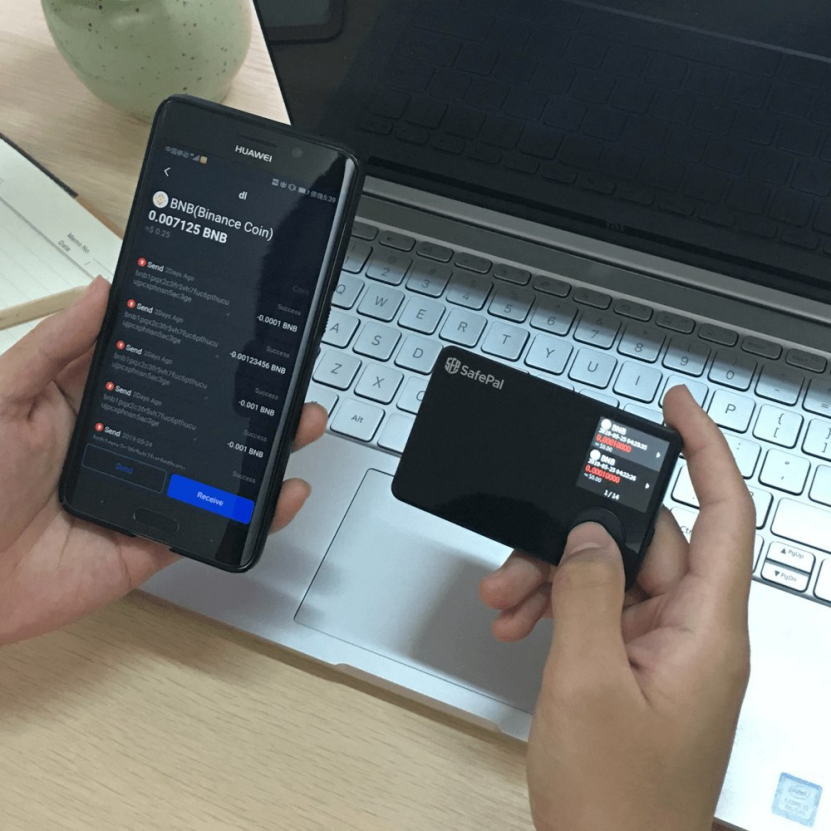
This pic shows a typical scenario when a user needs to transfer money to others.
Q: SafePal is funded by Binance and has many sponsoring organizations. Is there a functional advantage gained by this? Is there any possibility to get it in the future?
A: Binance as the strategic investor of SafePal, has provided strong support to our growth and expansion. SafePal is one of the earliest hardware wallets to support Binance ecosystem including Binance DEX, Binance mainnet, and Binance Academy. We are looking to build a robust long-term relationship with Binance to make SafePal more accessible to crypto users.
Q: 1) As a wallet invested by Binance, do you plan to turn SafePal into their official hardware wallet to exchange?
2) Can you explain the feature: “self-destruct and delete mechanism” so that users know what to do in case their wallet is hacked?
A: For the first question. We have already done that in January 2018

For the second question, when a hacker tries to initiate physical attack on the wallet device(such as brutal attack, radiofrequency attack, etc), the sensors embedded inside the SafePal S1 would detect such malicious attempt and initialize self-destruct mechanism, wiping all wallet data, including the private key, preventing any malicious attacker from getting the private key. That’s the basic structure of how this mechanism works.
Q: With the affecting of Covid-19, many companies/businesses got bankruptcy, how will SafePal team overpass this?
A: The COVID-19 indeed has a great impact on not only SafePal, but everyone. Our production line has been paused from January to early this month. It was not until 2 weeks ago that we started to gradually recover our manufacturing capacity. All of our team members have been working remotely from home. Thankfully we are still keeping high productivity. We have sufficient inventory for the next 3–4 months. Hope this pandemic situation passes ASAP and hope all of you be safe and sound.
Q: What are the biggest obstacles to your project when you implement it to the real world, and what is your plan to overcome these problems?
A: The biggest obstacle that we are facing is the limited market adoption at this moment. For now, the crypto adoption is less than 1% compared to internet adoption. There is a long way to go. Along with production iteration, we have also been paying close attention to user education, such as hosting #SAFE101 to share useful and simple tips to teach people how to protect their assets. A lot more blockchain companies should join hand-in-hand to boost user adoption in the long run.
Q: Why your hardware is cheaper than others like Ledger Nano or Trezor One?
Is it cheaper because it has a specific use or does it have various functions like the hardware mentioned above?
A: Thanks for the insightful question. We didn’t talk about pricing strategy much, but indeed the $39.99 retail price reveals our ambition to break the stereotype of ‘low price is equal to low quality’. We think a reasonable price is a guarantee that enables more crypto users to access a better and safer solution. We will be keeping the same strategy in the long run.
As for how we achieve it, it’s mostly related to our background. Our hardware team is led by experts with over 15 years of experience in hardware design, development and production. We know every detail of building great hardware at a reasonable price. In our last hardware project, we successfully sold our products to over 50 countries globally. That’s a strong foundation. We are not starting from 0.
For example, we bought at least 10 hardware wallets in our office. I have to say the BOM cost of many of these wallets is 1/10 of their retails price, sometimes even lower…
While the security level might not as be ideal as we expected.
Q: For me who invests a small value of not more than $300 I have not seen the urge of using a hardware wallet. I think it’s still safe enough to store my assets in Exchange. Because these assets are only for learning to trade.
What do I want to ask, Who is most recommended for using this hardware wallet? Are those with thick money and crypto assets in large amounts? Is it like me, with only a few crypto assets, also recommended ???
A: Interesting question. We actually did a survey about this before. According to our survey, the amount of crypto that our users are keeping with SafePal S1 varies from $200 to $800,000. So it typically shows that not just those who hold a huge amount of money are interested in a hardware wallet. From my perspective, I think security is no small thing, regardless of how many crypto you are holding with. Hardware wallet suits those who have a high standard for asset security. And SafePal is built for the users who care about not only security but also simplicity and smooth user experience.
Q: What are the advantage of SafePal that could encourage an individual to use it?
Are there any new features in SafePal that we could get as compare with other brands of hardware wallets?
A: Imagine you are a new beginner in crypto and blockchain, SafePal would be the best choice to consider.
Firstly it’s designed well. With the slick industrial design and advanced security specifications, SafePal is competitive with other hardware wallets.
Secondly it’s easy to use. Take sending money as an example, you can finish the transaction by a few scans, instead of plugging the wallet onto your PC. Not to mention that SafePal is mobile, you can manage your assets anytime, anywhere at your fingertips.
Last but not least, the highly cost-effective price point is no harm for you to give it a try. With $39.99 you can have a decent, Binance-backed, offline cold-storage hardware wallet. I think it’s easy to make a decision.
SafePal supports secure firmware upgrades, meaning that users will be able to on-board new features as time goes along. Coming next we have staking features, token swap features and a lot more on our coming plan. Welcome to subscribe from our homepage and stay tuned for our latest updates!
Q: SafePal is the first hardware wallet invested and backed by #BINANCE and #BINANCELABS. Can you share an insight relationship between SafePal and Binance groups?
Due to the Covid-19 Pandemic disrupts the flow of our life and put us all in danger. May I ask how does your manufacturing of #SafePal HardWallet affect? Any initiatives done or planned by the SafePal Team to help the community in fighting this virus?
A: Binance and Binance Labs have invested in diversified blockchain segments, such as layer 1, layer 2, security team, and Dapps. I think the wallet is a market segment that a blockchain giant like Binance cannot miss, because it’s the direct entrance to the blockchain ecosystem, with the great potential of connecting unlimited services built in the ecosystem.
I think Binance invested us mostly because
1) Both parties share the same long-term values. We are user-oriented and want to build tangible solutions rather than giving a fancy presentation;
2) We are not starting with 0. We have a proven track record in hardware and software.
3) The segment of crypto custody faces a lot of pain points and challenges, and we are offering the best solution to solve them.
We are working closely with Binance team on a monthly basis and have brought the community with many surprises. SafePal was one of the first hardware wallets that supported Binance mainnet, Binance DEX and other important Binance milestones. Looking forward to building the platform with more excellent partners like Binance. I think Qtum is exactly the one big platform that we are very willing to work with. 🙂
Q: SafePal really is one of the fastest-growing hardware wallets. Is there a hardware or software limit on how many coins the SafePal hardware wallet can support?
A: Haha. There is no limitation of the currencies that we supported. Till now we have supported 19 blockchains, 19 coins and 10K+ tokens. Users are free to add any available coin/token into their wallets. It’s very simple!
Q: Interesting, can you explain the features of the self-destruction mechanism in @iSafePal?
How SafePal secures every transaction and receipt of funds considering SafePal is not available USB, Bluetooth, Wifi, and NFC?
A: For Q1:
The self-destruction mechanism protects users’ crypto assets from physical attacks such as brutal attacks (someone cracks open the device), radiofrequency attack and voltage attack.
There are multiple sensors embedded around the secure element of SafePal S1. Once a malicious attempt is detected by one of the sensors, it’ll trigger the self-erasing mechanism, wiping all wallet data including the private key. Don’t worry about losing the money after the destruction. You can always recover your assets with the correct recovery seed on a new SafePal S1 device.
For Q2:
SafePal adopts an air-gapped signing mechanism rather than USB, Bluetooth, NFC or WiFi. This enables users to sign each transaction in a shorter distance with 0 internet environment. Once a user needs to send money out from SafePal S1, he/she can create a transaction on the SafePal App, scan the QR code on the App with the S1 device, confirm the transaction on S1, and then scan the QR code on S1 with the App. During all these procedures, the private key is 100% offline all the time.
Q: If a hardware wallet can be used as a debit card in the shops with the available tokens in the wallet, then it would be awesome. What’s your views on this?
A: This is indeed a very attractive and common scenario. To be honest, to achieve that goal, there is a long way to march on. The first problem is user adoption. This is the first big obstacle to keeping cryptocurrency from becoming a daily usage application. Even when the crypto adoption rate is increasing, there are still a lot of challenges coming from compliance and regulation. I believe this future will be happening sooner when more companies like SafePal and users like you folks are supporting the ecosystem. Keenly looking forward to the future where this might happen.
Q: The price of money does not reflect the development and benefits that the project brings, can you give people here a few reasons why they should invest and use @iSafePal now beyond?
A: 1. SafePal S1 is secure from in and out. It is offline, using air-gapped signing, no radiofrequency/WiFi/NFC/USB. It is built with the most advanced technologies from hardware and software levels. Details can be found in our Knowledgebase.
2. SafePal S1 is easy to use, even for new beginners
3. SafePal S1 is backed by a strong team that has strong faith in blockchain and commitment to building the best wallet solution for the masses.
Q: How is SafePal protected against security risks? You know that in recent years, many crypto currencies, stock markets, and wallets have been subjected to hacking attacks.
Does this doubt scare you and your team?
In the event of a potential attack, what procedures will your team implement to protect the assets of your users?
A: I can answer this question all day. lol
Will make it short here and those who are interested in digging out more details are welcome to reach out to us anytime.
We are not scared of the attacks. As a wallet provider, we are prepared for potential attacks from day one. Security is an endless war, and we are cautious and paying close attention to every detail of it.
SafePal forges its security from the hardware and software level:
【Hardware level】
100%offline, air-gapped signing mechanism, self-destruct mechanism, dual-chip architect, multiple sensors
【Software level】
Device authentication process, disrupted PIN code, security suffix, security password
【External effort】
Wallet penetration test with the prestigious security team such as WalleFail, who has hacked Ledger and Trezor multiple times(videos can be found on Youtube)
Thank you all for coming and thanks Qtum team for holding such a great AMA!
We will see you soon and welcome to follow our Twitter for more updates.






